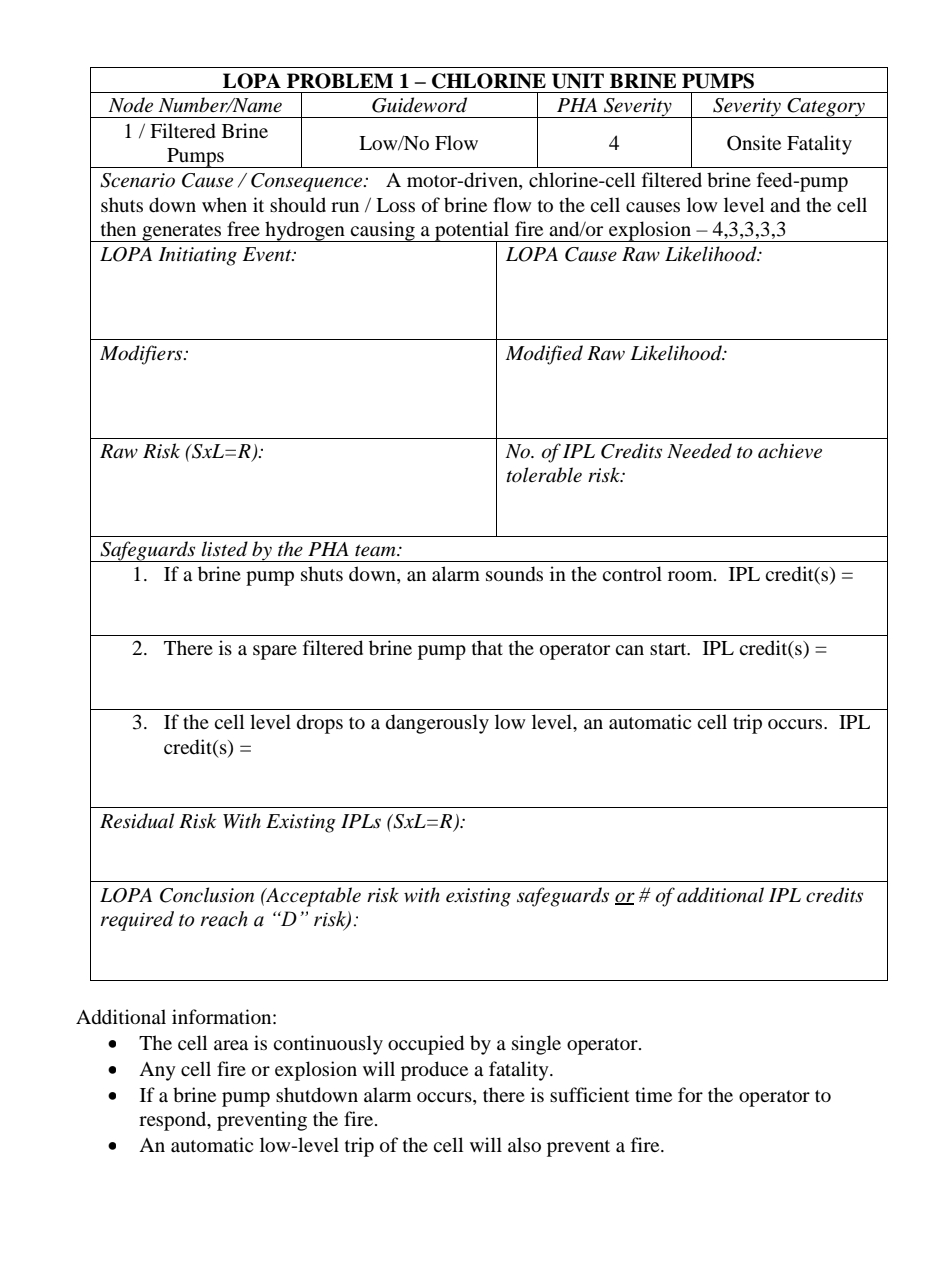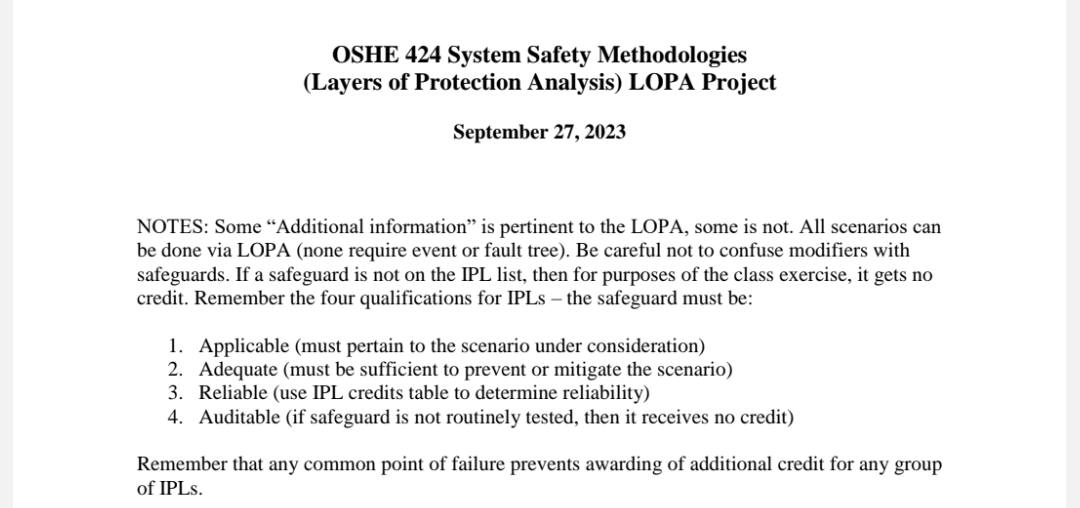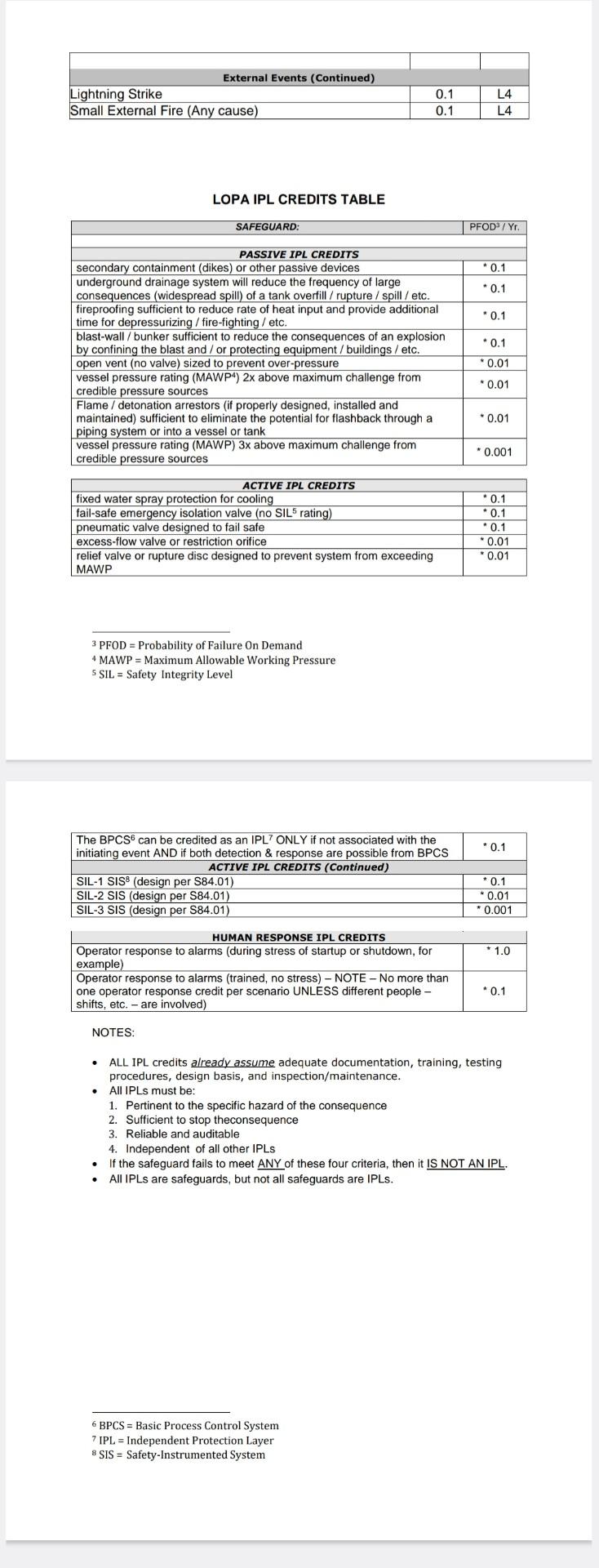Answered step by step
Verified Expert Solution
Question
1 Approved Answer
below is the rubric for the LOPA (Layers of Protection Analysis) question. NOTE: D and E risks are acceptable A, B, and C. risks are

below is the rubric for the LOPA (Layers of Protection Analysis) question.



NOTE: D and E risks are acceptable A, B, and C. risks are unacceptahle. LOPA INITIATING EVENTS TABLE Likelihood / Year 1 BLEVE = Boiling-Liquid, Expanding-Vapor Explosion 2 LFG = Liquefied Flammable Gas LOPA IPL CREDITS TABLE 3 PFOD = Probability of Failure On Demand 4 MAWP = Maximum Allowable Working Pressure 5SIL= Safety Integrity Level NOTES: - ALL IPL credits already assume adequate documentation, training, testing procedures, design basis, and inspection/maintenance. - All IPLs must be: 1. Pertinent to the specific hazard of the consequence 2. Sufficient to stop theconsequence 3. Reliable and auditable 4. Independent of all other IPLs - If the safeguard fails to meet ANY of these four criteria, then it IS NOT AN IPL. - All IPLs are safeguards, but not all safeguards are IPLs. NOTES: Some "Additional information" is pertinent to the LOPA, some is not. All scenarios can be done via LOPA (none require event or fault tree). Be careful not to confuse modifiers with safeguards. If a safeguard is not on the IPL list, then for purposes of the class exercise, it gets no credit. Remember the four qualifications for IPLs - the safeguard must be: 1. Applicable (must pertain to the scenario under consideration) 2. Adequate (must be sufficient to prevent or mitigate the scenario) 3. Reliable (use IPL credits table to determine reliability) 4. Auditable (if safeguard is not routinely tested, then it receives no credit) Remember that any common point of failure prevents awarding of additional credit for any group of IPLs. \begin{tabular}{|c|c|c|c|} \hline \multicolumn{4}{|c|}{ LOPA PROBLEM 1 - CHLORINE UNIT BRINE PUMPS } \\ \hline Node Number/Name & Guideword & PHA Severity & Severity Category \\ \hline 1/FilteredBrinePumps & Low/No Flow & 4 & Onsite Fatality \\ \hline \multicolumn{4}{|c|}{ScenarioCause/Consequence:Amotor-driven,chlorine-cellfilteredbrinefeed-pumpshutsdownwhenitshouldrun/Lossofbrineflowtothecellcauseslowlevelandthecellthengeneratesfreehydrogencausingapotentialfireand/orexplosion4,3,3,3,3} \\ \hline \multicolumn{2}{|l|}{ LOPA Initiating Event: } & \multicolumn{2}{|c|}{ LOPA Cause Raw Likelihood: } \\ \hline \multicolumn{2}{|l|}{ Modifiers: } & \multicolumn{2}{|c|}{ Modified Raw Likelihood: } \\ \hline \multicolumn{2}{|l|}{ Raw Risk (SxL=R) : } & \multicolumn{2}{|c|}{No.ofIPLCreditsNeededtoachievetolerablerisk:} \\ \hline \multicolumn{4}{|c|}{ Safeguards listed by the PHA team: } \\ \hline \multicolumn{4}{|c|}{ 1. If a brine pump shuts down, an alarm sounds in the control room. IPL credit(s) =} \\ \hline \multicolumn{4}{|c|}{ 2. There is a spare filtered brine pump that the operator can start. IPL credit(s) =} \\ \hline \multicolumn{4}{|c|}{3.Ifthecellleveldropstoadangerouslylowlevel,anautomaticcelltripoccurs.IPLcredit(s)=} \\ \hline \multicolumn{4}{|c|}{ Residual Risk With Existing IPLs (SxL=R) : } \\ \hline \multicolumn{4}{|c|}{LOPAConclusion(Acceptableriskwithexistingsafeguardsor#ofadditionalIPLcreditsrequiredtoreacha"D"risk):} \\ \hline \end{tabular} Additional information: - The cell area is continuously occupied by a single operator. - Any cell fire or explosion will produce a fatality. - If a brine pump shutdown alarm occurs, there is sufficient time for the operator to respond, preventing the fire. - An automatic low-level trip of the cell will also prevent a fire
Step by Step Solution
There are 3 Steps involved in it
Step: 1

Get Instant Access to Expert-Tailored Solutions
See step-by-step solutions with expert insights and AI powered tools for academic success
Step: 2

Step: 3

Ace Your Homework with AI
Get the answers you need in no time with our AI-driven, step-by-step assistance
Get Started


